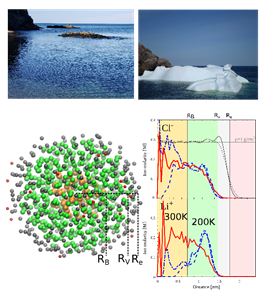Brine Rejection in Aqueous Supercooled Aerosol Droplets
Supervisor: Dr. Styliani (Stella) Constas
Can extend to MSc?: Yes
Project Description (Abstract):
Charged droplets with multiple ions are ubiquitous in atmospheric and man-made aerosols. The chemistry within the droplets is very intriguing and different from that of their planar interface counterparts. Recently (see reference), we found computationally that in supercooled aqueous droplets (200K) cosmotropic ions are rejected from the droplet core, where the water molecules form a distinctly organized tetrahedral network. In this project we will (a) characterize the core structure, (b) study the brine rejection process within supercooled aqueous droplets. Part (a) of the study involves the use of advanced sampling methods (beyond direct molecular dynamics) for the sampling of the molecular states of frustrated systems. In addition new diagnostics will be used to analyze the core structure. In part (b) the ion spatial distribution in droplets will be studied. The study may also involve macroions. The molecular modelling will take place using molecular dynamics, parallel tempering, simulated annealing and other advanced sampling techniques and the results will be compared with the solution of the non-linear Poisson Boltzmann (PB) equation. The software for the solution of the non-linear PB has been created in the group. Molecular simulations will be performed using the state-of-the-art software NAMD. The electric field on the droplet surface will be computed with methods and software developed in the group. The student(s) doing the project should be willing to learn computer programming skills. The project will not be affected by any changes due to the pandemic. The project has multiple sequential steps that are self-contained. The student may complete a project for an undergraduate thesis at intermediate stages of part (a) or (b).

References: S. Consta et al. "Low Density Interior in Supercooled Aqueous Nanodroplets Expels Ions to the Subsurface’’, J. Am. Chem. Soc., 2021 https://doi.org/10.1021/jacs.1c04142

